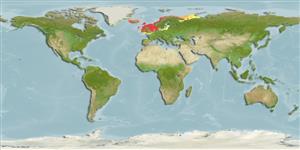Environment: milieu / climate zone / depth range / distribution range
Ecología
marino; salobre bentopelágico; rango de profundidad 10 - 150 m (Ref. 35388), usually 10 - 150 m (Ref. 35388). Temperate; 73°N - 49°N, 54°W - 60°E
Northeast Atlantic: 74°N (Novaya Zemlya and Bear Islands) to 49°N (Channel Islands, western English Channel), including eastern Greenland, Iceland, Barents Sea (but not the White Sea) and the Baltic (but not the Gulf of Bothnia and Finland).
Length at first maturity / Tamaño / Peso / Age
Maturity: Lm ?, range 11 - ? cm
Max length : 25.0 cm TL macho / no sexado; (Ref. 232); edad máxima reportada: 10 años (Ref. 35388)
Short description
Morfología | Morfometría
Espinas dorsales (total): 0; Radios blandos dorsales (total): 56-63; Radios blandos anales: 29 - 33. Scales absent from a median band anterior to the dorsal fin and from the musculature at the base of caudal fin. Belly scales loosely arranged, not in chevrons. Vertebrae 65-75. Margins of dorsal and anal fins straight with rays of equal length. Lateral line pores linearly arranged along the unbranched canals.
This schooling species is usually territorial and burrowing (Ref. 40). Feed on plankton. High activity is correlated to periods with strong tidal currents; then they leave their bottom hides and form large shoals. During low light intensity (night and winter) they bury in the bottom (Ref. 35388).
Muus, B.J. and J.G. Nielsen, 1999. Sea fish. Scandinavian Fishing Year Book, Hedehusene, Denmark. 340 p. (Ref. 35388)
IUCN Red List Status (Ref. 130435)
Threat to humans
Harmless
Human uses
Pesquerías: comercial
Más información
ReferenciasAcuiculturaPerfil de acuiculturaRazasGenéticaElectrophoresesheritabilidadEnfermedadesProcesamientoNutrientsMass conversion
Herramientas
Special reports
Download XML
Fuentes de Internet
Estimates based on models
Preferred temperature (Ref.
123201): 6.7 - 11, mean 9.7 °C (based on 1058 cells).
Phylogenetic diversity index (Ref.
82804): PD
50 = 0.5156 [Uniqueness, from 0.5 = low to 2.0 = high].
Bayesian length-weight: a=0.00275 (0.00205 - 0.00370), b=3.14 (3.07 - 3.21), in cm total length, based on LWR estimates for this species (Ref.
93245).
Nivel trófico (Ref.
69278): 3.3 ±0.40 se; based on food items.
Resiliencia (Ref.
120179): Medio, población duplicada en un tiempo mínimo de 1.4-4.4 años (K=0.16-0.89; tm=1-3; tmax=10; Fec=4,000).
Fishing Vulnerability (Ref.
59153): Low to moderate vulnerability (30 of 100).
Nutrients (Ref.
124155): Calcium = 44.2 [24.8, 86.8] mg/100g; Iron = 0.34 [0.20, 0.60] mg/100g; Protein = 18.6 [17.2, 19.8] %; Omega3 = 0.448 [0.217, 0.891] g/100g; Selenium = 14.2 [5.9, 30.8] μg/100g; VitaminA = 36.1 [12.4, 109.0] μg/100g; Zinc = 0.825 [0.582, 1.152] mg/100g (wet weight);
